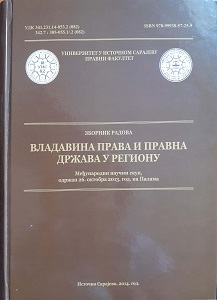Непосредно дејство права Европске уније у правним системима
Direct Effects of European Union Law in the Legal Systems of Member States
Author(s): Zoran Radivojević
Subject(s): EU-Legislation
Published by: Правни факултет Универзитета у Источном Сарајеву
Keywords: Direct application;Direct effect;Vertical effect;Horizontal effect;International treaties;Regulations;Decisions;Directives
Summary/Abstract: The founding treaties of the European Union do not recognize the notion of direct effect, but only direct application, which is specifically related to regulations as specific and the most important type of EU legal acts. Direct effect is nowadays a widely accepted principle of European Union law, despite the fact that it is not explicitly mentioned. As a creation of the Court of Justice, this principle defines that provisions of EU law directly create rights and obligations for natural and legal persons in Member States which can be lawfully invoked before national authorities and courts. At the same time, it bounds the courts of Member States to apply the norm referred to by the individual subject, and so ensure the realization of this right.The Court of Justice of the EU at first only recognized direct effect to provisions of the founding treaties, but later on it extended the scope of application of this principle in several directions. Thus, provisions contained in other international treaties, which constitute primary sources of EU law, were also recognized as to having direct effect. These inter-national treaties, which the Union concludes on grounds of its contractual capacity, are ones concluded with non-member states or other international organizations.Furthermore, the case law began to distinguish two types of legal issues that arose regarding the direct effect of provisions of international treaties. The Court of Justice initially recognized that individual subjects can only refer to their subjective rights established by these provisions in respect to (versus) a Member State. This is the so-called vertical direct effect whereby the individual is opposed to the state government. After-wards, the Court of Justice accepted the so-called horizontal direct effect of contractual provisions, which is the possibility that an individual can call upon provisions of an international treaty which stipulates duties of another individual subject for the protection of their individual rights, be-fore a national authority or court. Finally, parallel with the expansion of treaty provisions that have direct effect, the jurisprudence confirmed that other sources of EU law may also have this type of effect. The Court of Justice included the norms contained in so-called secondary legislation, which is provisions of regulations, decisions and directives issued by the EU institutions, to the set of legal rules with direct effect
- Page Range: 905-924
- Page Count: 20
- Publication Year: 2013
- Language: Serbian
- Content File-PDF

